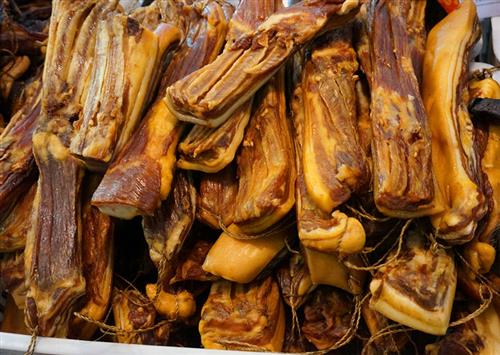How to save bacon? Bacon purchase and preservation
Bacon is a processed product made from the process of curing and then baking or sun exposure. Bacon is rich in phosphorus, potassium, and sodium, and also contains fat, protein, and carbohydrates. Bacon purchasing method If the bacon has a bright color, the muscles are bright red or dark red, and the fat is transparent or milky white. The body is dry, firm, and full of elasticity, and it has a cured bacon flavor that is a good bacon. Conversely, if the flesh is dark and dull, yellowish fat, mildew, soft flesh, inelasticity, mucus, acid rancidity, or other offensive odors, it is deteriorating or defective. When you buy, you should choose a dry, no smell or sour taste. The meat is bright. If the lean part is black, the fat is dark yellow, indicating that it has exceeded the shelf life and should not be purchased. Buy food safety tips For some reason, some unscrupulous traders illegally make bacon, use state-prohibited additives (such as: industrial salt, unsafe dyes, etc.) and expired metamorphic meat products. Consumers are required to pay attention to regular manufacturers and merchants at the time of purchase. , and pay attention to observe the relevant information on the label and color of bacon. Bacon preservation method As a meat product, bacon is not a long-lasting thing. After the winter solstice, bacon made before the Great Han Dynasty has been preserved for the longest and is not easy to deodorize. Bacon is kept at room temperature. The taste is most authentic before the lunar calendar three months ago. As the temperature rises, although the meat does not change, the taste will become stabbing. Therefore, after the lunar calendar in March, bacon cannot be preserved at room temperature. The best way to preserve it is to wash the bacon, wrap it in plastic wrap, and put it in the freezer of the refrigerator so that it can be stored for a long time and it will not turn off even if it is for three to five years. Bacon should not be placed too long Generally, the winter temperature is low and the humidity is not high. If you plan to finish eating within two weeks, and the indoor temperature is below 20 degrees Celsius and the humidity is lower than 60%, you can not put it in the refrigerator, just put it in a ventilated, cool place. Conveniently. If you need to save for a long time, you can first dry the dried savory food and dry it, pack it in a fresh-keeping bag and serve it in a freezer, store it in the refrigerator freezer, and store it for six months. However, it is still recommended that you eat as soon as possible. Because the bacon requires a dry environment, it is not suitable for storage in a refrigerator freezer. Foods such as fruits and vegetables are often found in the cold room, and the humidity is relatively high, which easily leads to moldy mildew. If there is only a slight mildew on the surface, it can be wiped clean with warm water and ventilated; if there is more mildew, it is not recommended to eat. The bacon that was bought back also had particular attention to its storage method. “Overall, the low-temperature, dry environment is suitable for the preservation of preserved meat.†The shelf life of bacon is generally 3 to 6 months. According to the moisture content of the bacon itself, the ambient temperature and humidity, the shelf life is also different, such as more than 6 Months, quality is hard to guarantee. Diagnostic reagents can be divided into two categories: in vivo diagnostic reagents and in vitro diagnostic reagents. It is mostly a reagent for detection by the reaction between antigen and antibody. Urine Rapid Test Kit,Rapid Test Kit 6-Panel,Toxoplasma rapid test kits,Fecal Occult Blood Test Jilin Sinoscience Technology Co. LTD , https://www.contoryinstruments.com
A: Classification of in vitro diagnostic reagents:
1. In vitro biodiagnostic reagents managed as drugs include:
1. Blood type and tissue type reagents;
2. Microbial antigen, antibody and nucleic acid detection reagents;
3. Tumor marker reagents;
4. Immunohistochemistry and human tissue cell reagents;
5. Human genetic testing reagents;
6. Biochips;
7. Allergy diagnostic reagents.
2. In vitro reagents managed as medical devices include:
1. Clinical basic test reagents;
2. Clinical chemistry reagents;
3. Blood gas and electrolyte determination reagents;
4. Vitamin determination reagents;
5. Cell histochemical stains;
6. Autoimmune diagnostic reagents;
7. Microbiological test reagents.
B: According to medical test items, clinical diagnostic reagents can be roughly divided into clinical chemical test reagents, immunology and
Serological testing reagents, hematological and cytogenetic testing reagents, microbiological testing reagents, body fluid excretion
Detection reagents, genetic diagnosis reagents, etc. Among them, the market share of clinical chemistry
The largest, close to 34%; followed by the immunology market, accounting for about 29%. Novel immunodiagnostic reagents and genetic diagnostic tests
The reagent was developed in the late 1980s, and it is the most common diagnostic reagent for all current diagnostic reagents, regardless of technology or market.
The fastest growing product.
